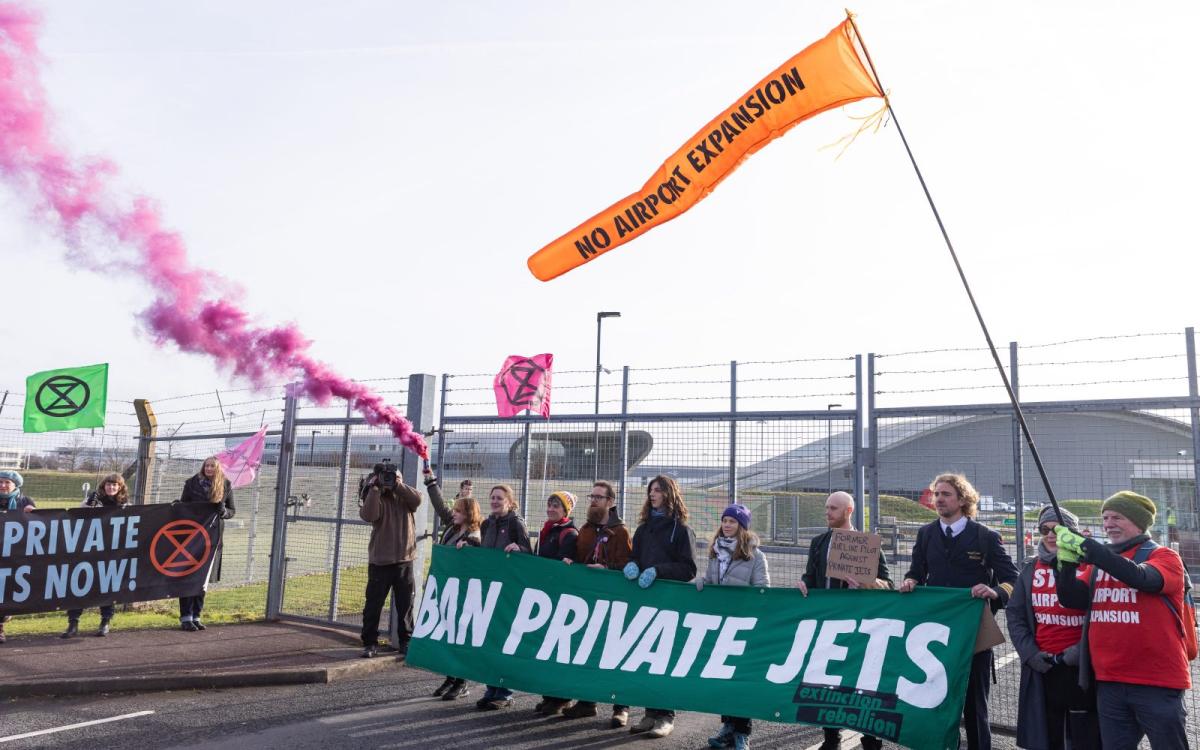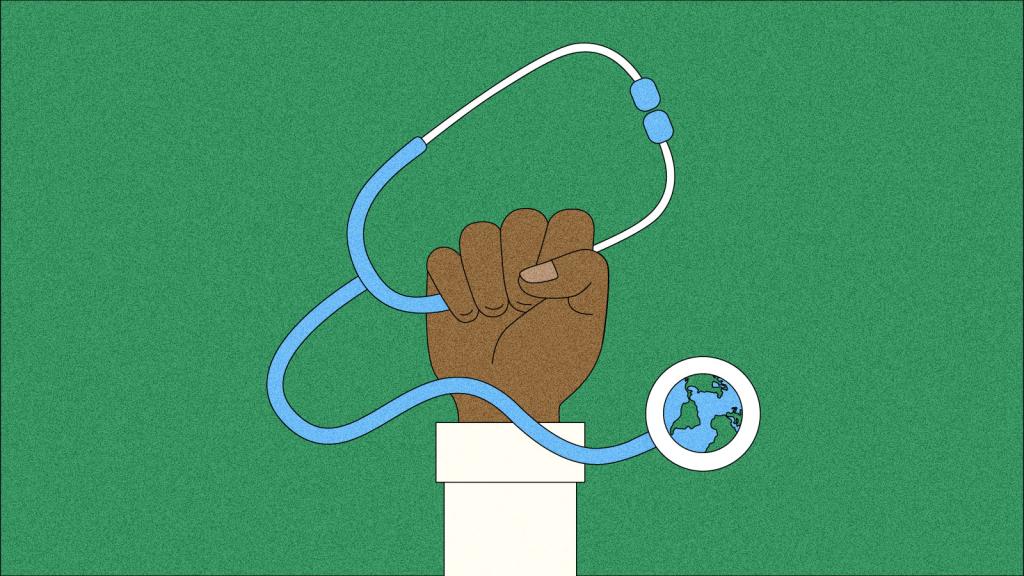
The vision
“You used to go to India every year, Ammamma?” Reyna asks me, eyes wide.
“Every year. We were very lucky.”
“Do you think you’ll ever go back?”
“With the flight restrictions, it’s almost impossible,” I say. “Now I think it’d take me three trains and a whole-ass ship. No, I don’t think I’ll ever be able to go back. But sometime in the future … I think you will.”
— a passage from “Cabbage Koora,” by Sanjana Sekhar
The spotlight
Nearly 4 in 5 people support doing “whatever it takes” to mitigate climate change, according to a survey published late last year by the firm Potential Energy. An increasingly large majority of people the world over want to see their governments taking decisive action.
But support for specific policies is somewhat of a different story. Notably, in the same survey, messaging about a “mandate,” “ban,” or even “phaseout” received less support than the prompts that didn’t include those words — in some cases, up to 20 percentage points lower. “This finding is particularly important as climate policy advances from the ‘behind-the-scenes’ policies like clean energy standards to the policies that more directly affect individual citizens’ lives — in their kitchens, homes, garages, and farms,” the survey report noted.
This week’s drabble is a snippet from the cli-fi short story “Cabbage Koora: A Prognostic Autobiography” — one of the finalists in this year’s Imagine 2200 contest, a Grist project that asks writers to envision hopeful climate futures. In “Cabbage Koora,” we see a future where everybody (or at least, the characters we meet) does their part: Cities are rewilded, food is grown in front yards, and cooperatives are formed around sharing resources and volunteering. Another aspect of that future is limiting carbon-intensive forms of travel. In three vignettes, spanning 2023 to 2077, the main character grows from a young woman living in L.A. who visits her grandmother in India once a year to a grandmother herself, living in a much changed L.A., where long-distance travel is heavily restricted.
Although the regulations aren’t described in detail, author Sanjana Sekhar references something akin to a carbon crediting system, in a conversation where the main character’s daughter tries to convince her to visit them in Duluth, Minnesota:
“OK, so India’s off the table,” Gita says, cutting off my thoughts, “but more realistically, can you come here, Amma? I told you, Gloria and I can arrange for the flight permits — we have so many credits from volunteer days with the ceremonial burning crews.”
In this fictional tale, the family seems happy enough to accept the climate-conscious travel restrictions. They stay in touch through increasingly sophisticated communication technology, and they share in preserving cultural and culinary traditions, from afar. But what the story doesn’t show is how society arrived at this restricted future — and any opposition that may have stood in the way.
Is this a realistic version of how we might address the carbon intensity of air travel? And if so, will people adapt, as readily as the characters in “Cabbage Koora” seem to? In today’s newsletter, we’re exploring “fiction to reality” — the link between one imagined aspect of a clean, green, just future and the seeds of that future that are visible today.
[Read more “fiction to reality” based on past Imagine contests]
![]()
“It’s unrealistic to think that regulation can work on its own,” said Matto Mildenberger, an assistant professor and researcher who specializes in climate politics and political drivers of policy inaction. That’s partly to do with public opinion — preventing people from doing things they want to do is unlikely to be a winning proposition. But, Mildenberger said, the more significant source of opposition is the companies and trade groups that stand to lose out in the green transition. “You can’t expect a large industry that profits from selling a product to sort of quietly go into the sunset.”
The debate around gas stoves in the U.S. provides an interesting case study. The gas industry has been selling the public on their superiority for well over a century, including with a catchphrase popularized in the 1940s that’s still around today: “Now we’re cooking with gas.” More recently, gas companies have paid social media influencers to extoll the unique virtues of cooking over a gas flame. And these techniques appear to be working to stall electrification efforts. (Mildenberger co-authored a recent survey that found that 31 percent of Americans want a fully electric home; an additional 29 percent would like an electric home with a carve out for their gas stoves.)
Earlier this month, a federal appeals court upheld a ruling that struck down a ban on natural gas in new buildings in Berkeley, California. Although the ban was not specific to stoves, they quickly became the focal point; the lawsuit against Berkeley’s ban was brought by the California Restaurant Association, which claimed that the local government was overstepping in trying to regulate the appliances Americans use in their homes. That 2019 law was the first of its kind in the nation, and the ruling casts doubt on the dozens of cities that had followed Berkeley’s lead.
For Mildenberger, this has been evidence of one of the reasons he thinks “bans” are a risky strategy when it comes to changing public behavior. “I think that these bans have turned out to be a very useful and salient rallying cry that the fossil fuel industry has been able to use to mobilize the public,” he said. While political scientists and economists are far from unified in their thinking around these issues, Mildenberger’s perspective is that policies to help people understand and reap the benefits of making a change are crucial drivers in effecting that transition, and eventually can bring public opinion to a place where opposition to a ban wouldn’t be as easy to stir up. In the case of home gas usage, if a ban is coupled with, for instance, incentives to purchase heat pumps and other electric appliances, it can be framed more as a push toward more efficient, safer homes and less as a phaseout of natural gas.
“I think that, in all likelihood, the real transformative change that happens in our home electrification systems is going to come from the benefits that people perceive rather than a ban,” he says. “On the other hand, you know, it’s 2024 now. We have at most 10 years before this particular window of addressing some of the worst impacts of climate change closes.”
![]()

A group of climate activists, including Greta Thunberg, gathered in Farnborough, U.K., earlier
this month to protest a planned airport expansion and call for a ban on private jets. Mark Kerrison / Getty Images
When it comes to flying, many companies are working to develop sustainable aviation fuels and even electric aircraft — but these technologies aren’t yet commercially available. That means that reducing the carbon footprint of flying, whether by choice or by law, currently means accepting some restricted mobility — or a different mode of transport.
Last May, France became a test case in flight restrictions when it officially banned short-haul domestic flights on routes already serviced by high-speed rail routes. Perhaps unsurprisingly, the ban was challenged by the Union of French Airports and the European branch of the Airports Council International — but, in contrast to the American courts in the natural gas example, the European Commission ultimately gave France’s ban the green light.
One reason for the different outcomes stems from EU law: The Air Service Regulation sets rules for air services in the EU, and specifically allows member states to limit air traffic rights due to environmental concerns when other transportation is available.
Another key difference: The flight ban’s origins actually lie in public opinion: A more ambitious version was originally recommended by the Citizens’ Convention for the Climate that the French government convened in 2019 and 2020.
The version of the ban that ultimately passed is severely limited, which has been a source of criticism from climate advocates. It currently only affects three routes, from Paris’s Orly airport to the cities of Nantes, Lyon, and Bordeaux. In order to fall under the regulation, the comparable train journey must be no longer than 2.5 hours, with frequent and timely service, and it doesn’t apply to connecting flights. But because the nature of the ban is to essentially replace short plane trips with comparable train travel, the government could restrict more routes when the measure comes up for review in three years, as the country continues to improve its rail system. And several other European countries are eyeing similar legislation.
![]()
A 2022 study in Germany looked at what exactly motivates people to want to fly less, and to support policies that would restrict flights. One of the strongest factors was “perceived behavioral control” — people who felt they had options to travel without flying were less likely to fly in the first place, and more likely to support environmental policies that would reduce air travel. It’s the same story Mildenberger pointed to with heat pumps and induction stovetops, and the same idea behind France’s ban: If people have appealing replacements for carbon-intensive activities, they’re more likely to give those up — and less likely to see it as a sacrifice.
“The existence of alternatives and the associated perception of control over (sustainable) travel options are central to promoting sustainable mobility,” the study concluded.
The survey also looked at whether people’s attitudes toward air travel would be swayed when they were informed about its impacts, both within Germany and globally. “What was surprising to me is that we provided information on the different justice aspects, and none of that had any influence on people’s intentions,” said Jessica Berneiser, a psychologist and the study’s lead author. One test group received supplemental information explaining how the climate cost of air travel is unfairly distributed, while less than 5 percent of the world’s population has ever even been on an airplane. But these global justice concerns didn’t sway the respondents.
In some ways, it goes to show why regulations are necessary in the first place. “Information is not everything,” Berneiser said. “We cannot rely on, ‘If we just inform people about all the negative effects, the world will be a great place.’ We need policy to actually support climate-friendly behavior.”
But while global justice didn’t rise to the top as an indicator of support for reduced air travel, another type of justice did: intergenerational. Concerns for future generations and the disproportionate climate burdens that they will bear was a strong factor. And while a sense of behavioral control over different travel options more strongly predicted people’s personal intentions to fly less, Berneiser noted, a belief in intergenerational justice was a stronger predictor of support for policies to reduce air travel.
The survey by Potential Energy that found support for doing “whatever it takes” to mitigate climate change turned up a similar finding to the flight study: Generational messaging proved to be 12 times more motivating than other narratives tested. The report called this framing “Later is too late,” because “it’s putting our children’s futures at risk” and “it’s our responsibility to leave behind a world that’s safe and livable for future generations.”
This is a theme that lies at the heart of “Cabbage Koora.” It’s a story about family, and the passing on of traditions and values and a persistent hope for a better future. At the story’s ending, the main character reflects:
I think of the two generations before me, who saw the world change so much in their own lifetimes: my ammamma watching India gain independence from the British Raj, and my amma, moving to a completely different continent and building a new life from scratch.
I think of the two generations after me: Gita, who didn’t see stars for the first three decades of her life until regulations helped clear the smog. Reyna, who’s never seen the snow but can do 31 chakkars and accompanies her mom to volunteer for ceremonial burn support.
I think of the descendants that follow, from whom I borrow this earth.
— Claire Elise Thompson
More exposure
- Read: a previous fiction-to-reality newsletter that looked at airships as a potential low-carbon form of travel
- Read: how other cities are learning from the defeat of Berkeley’s ban and finding alternative ways to electrify buildings (Grist)
- Read: about the growing coalitions of climate-concerned citizens who have given up flying (New York Times)
- Read: about two high-speed rail lines under development in the Western U.S., thanks to new federal funding (Condé Nast Traveler)
A parting shot
A photo of the Tokaido Shinkansen, the world’s first bullet train line, which started running in Japan in 1964 and remains part of a sophisticated network that connects the country. Smart Cities Dive ranks Japan number one in global leaders of high-speed rail infrastructure.




